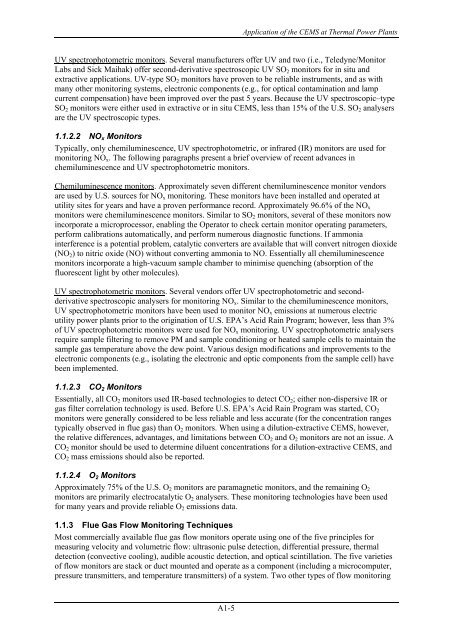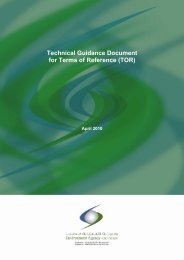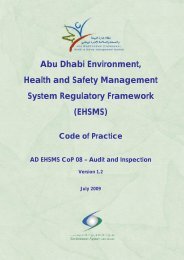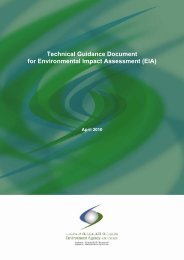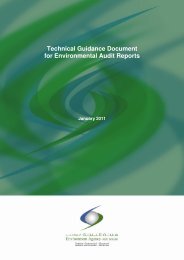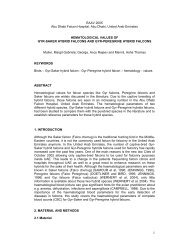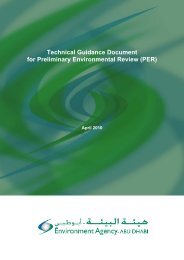Standard Operating Procedure (SOP) for Compliance Monitoring ...
Standard Operating Procedure (SOP) for Compliance Monitoring ...
Standard Operating Procedure (SOP) for Compliance Monitoring ...
Create successful ePaper yourself
Turn your PDF publications into a flip-book with our unique Google optimized e-Paper software.
Application of the CEMS at Thermal Power Plants<br />
UV spectrophotometric monitors. Several manufacturers offer UV and two (i.e., Teledyne/Monitor<br />
Labs and Sick Maihak) offer second-derivative spectroscopic UV SO 2 monitors <strong>for</strong> in situ and<br />
extractive applications. UV-type SO 2 monitors have proven to be reliable instruments, and as with<br />
many other monitoring systems, electronic components (e.g., <strong>for</strong> optical contamination and lamp<br />
current compensation) have been improved over the past 5 years. Because the UV spectroscopic–type<br />
SO 2 monitors were either used in extractive or in situ CEMS, less than 15% of the U.S. SO 2 analysers<br />
are the UV spectroscopic types.<br />
1.1.2.2 NO x Monitors<br />
Typically, only chemiluminescence, UV spectrophotometric, or infrared (IR) monitors are used <strong>for</strong><br />
monitoring NO x . The following paragraphs present a brief overview of recent advances in<br />
chemiluminescence and UV spectrophotometric monitors.<br />
Chemiluminescence monitors. Approximately seven different chemiluminescence monitor vendors<br />
are used by U.S. sources <strong>for</strong> NO x monitoring. These monitors have been installed and operated at<br />
utility sites <strong>for</strong> years and have a proven per<strong>for</strong>mance record. Approximately 96.6% of the NO x<br />
monitors were chemiluminescence monitors. Similar to SO 2 monitors, several of these monitors now<br />
incorporate a microprocessor, enabling the Operator to check certain monitor operating parameters,<br />
per<strong>for</strong>m calibrations automatically, and per<strong>for</strong>m numerous diagnostic functions. If ammonia<br />
interference is a potential problem, catalytic converters are available that will convert nitrogen dioxide<br />
(NO 2 ) to nitric oxide (NO) without converting ammonia to NO. Essentially all chemiluminescence<br />
monitors incorporate a high-vacuum sample chamber to minimise quenching (absorption of the<br />
fluorescent light by other molecules).<br />
UV spectrophotometric monitors. Several vendors offer UV spectrophotometric and secondderivative<br />
spectroscopic analysers <strong>for</strong> monitoring NO x . Similar to the chemiluminescence monitors,<br />
UV spectrophotometric monitors have been used to monitor NO x emissions at numerous electric<br />
utility power plants prior to the origination of U.S. EPA’s Acid Rain Program; however, less than 3%<br />
of UV spectrophotometric monitors were used <strong>for</strong> NO x monitoring. UV spectrophotometric analysers<br />
require sample filtering to remove PM and sample conditioning or heated sample cells to maintain the<br />
sample gas temperature above the dew point. Various design modifications and improvements to the<br />
electronic components (e.g., isolating the electronic and optic components from the sample cell) have<br />
been implemented.<br />
1.1.2.3 CO 2 Monitors<br />
Essentially, all CO 2 monitors used IR-based technologies to detect CO 2 ; either non-dispersive IR or<br />
gas filter correlation technology is used. Be<strong>for</strong>e U.S. EPA’s Acid Rain Program was started, CO 2<br />
monitors were generally considered to be less reliable and less accurate (<strong>for</strong> the concentration ranges<br />
typically observed in flue gas) than O 2 monitors. When using a dilution-extractive CEMS, however,<br />
the relative differences, advantages, and limitations between CO 2 and O 2 monitors are not an issue. A<br />
CO 2 monitor should be used to determine diluent concentrations <strong>for</strong> a dilution-extractive CEMS, and<br />
CO 2 mass emissions should also be reported.<br />
1.1.2.4 O 2 Monitors<br />
Approximately 75% of the U.S. O 2 monitors are paramagnetic monitors, and the remaining O 2<br />
monitors are primarily electrocatalytic O 2 analysers. These monitoring technologies have been used<br />
<strong>for</strong> many years and provide reliable O 2 emissions data.<br />
1.1.3 Flue Gas Flow <strong>Monitoring</strong> Techniques<br />
Most commercially available flue gas flow monitors operate using one of the five principles <strong>for</strong><br />
measuring velocity and volumetric flow: ultrasonic pulse detection, differential pressure, thermal<br />
detection (convective cooling), audible acoustic detection, and optical scintillation. The five varieties<br />
of flow monitors are stack or duct mounted and operate as a component (including a microcomputer,<br />
pressure transmitters, and temperature transmitters) of a system. Two other types of flow monitoring<br />
A1-5


